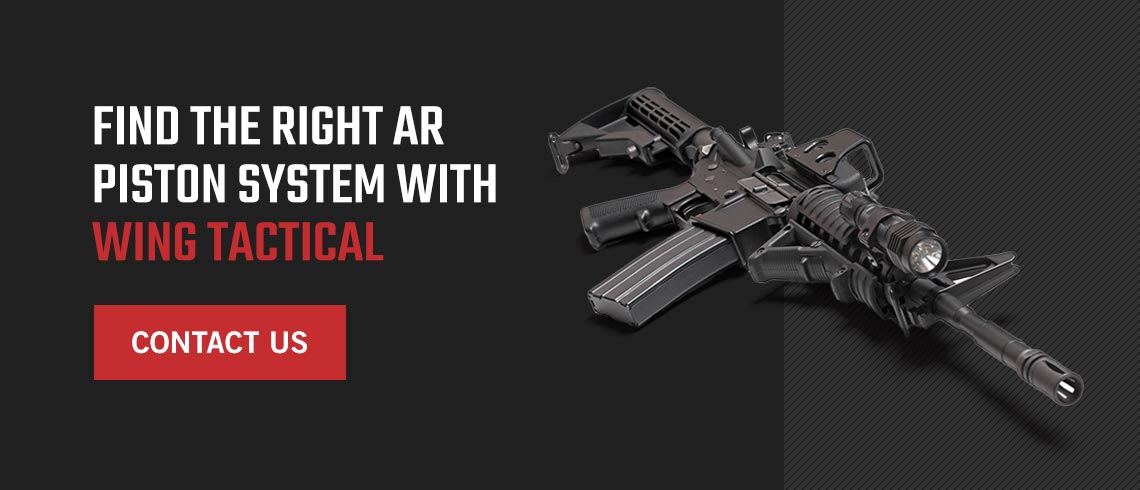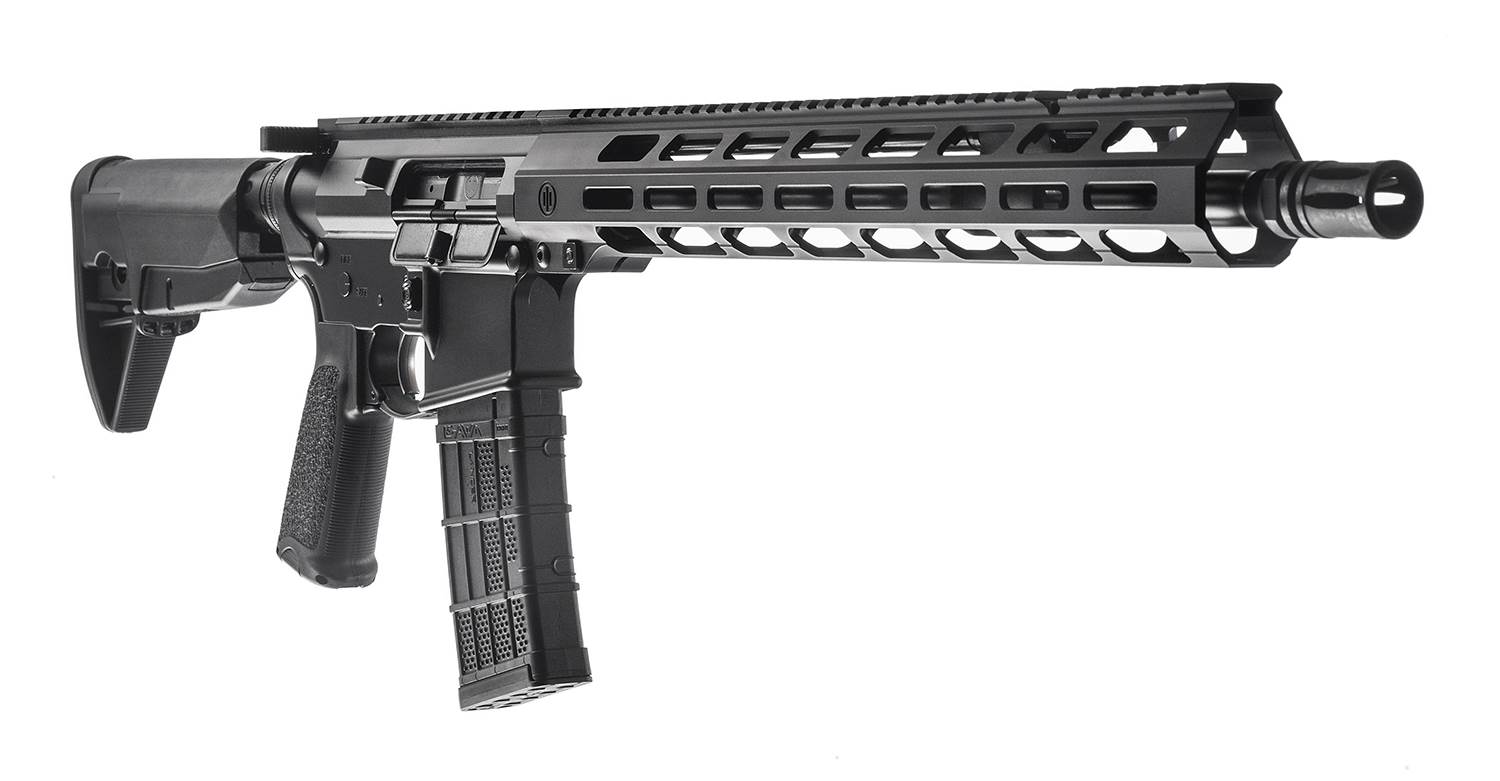
When purchasing an AR-15 for the first time or upgrading your current one, the gas system is an important consideration. Plus, AR-15 gas systems can be rather confusing if you're unfamiliar with the different types available. This can make it challenging to choose the right one when buying your first AR-15 or selecting parts. But fret not — we're here to help.
Are you trying to decide between direct impingement versus gas piston? This guide will explore each system in detail to help you determine which one is right for you.
The Difference Between Gas Piston and Direct Impingement Technology for an AR-15
Let's dive into the pros and cons of direct impingement and piston-driven AR systems and look at how each system operates.
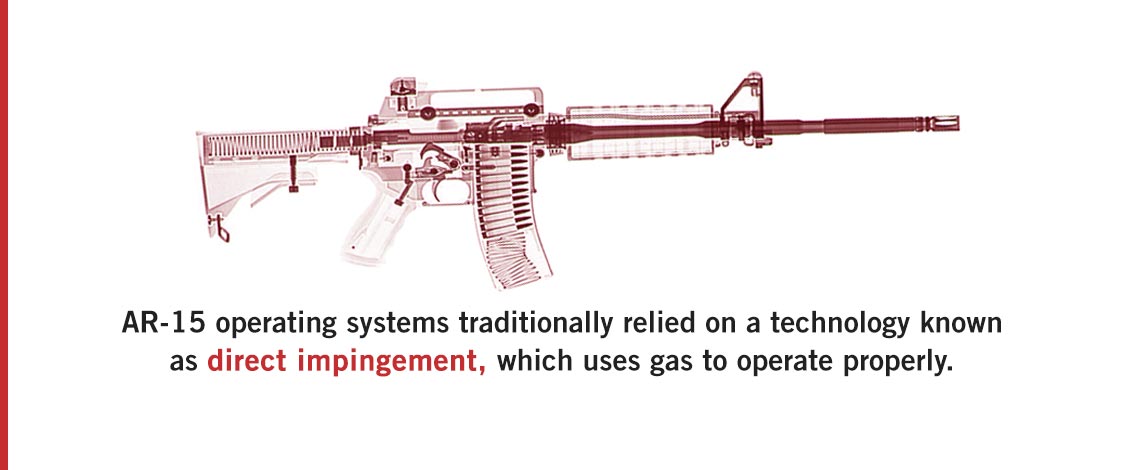
How Do the Original AR-15 Models Work?
AR-15 operating systems traditionally relied on a technology known as direct impingement, which uses gas to operate properly. With direct impingement, the firing pin strikes the primer and delivers the bullet down the barrel of the gun, causing the propellant gas to accumulate behind the bullet.
The gas then bleeds out through a small hole in the barrel and is channeled into the gas tube. Next, the gas “impinges” the bolt carrier mechanism, causing the bolt to move in a backward motion and compress the buffer spring. The spring then continues the cycle by picking up the next round.
The gas impingement system is straightforward with relatively minimal components. Its three main elements are:
- Gas block: The gas block is essentially a gathering and routing area for gases released through the small opening in the barrel. Gas blocks come in multiple types and styles, but they all share a mutual goal — collecting gases from the barrel, then sending them back to the bolt carrier by pushing them through the gas tube.
- Gas tube: Attached to the gas block on one end and the gas key on the other end, the gas tube creates a path for gases to travel back to allow the bolt carrier group to cycle.
- Gas key: The gas key attaches to one end of the gas tube. It enables the gases forced back from the gas block and barrel to enter the receiver, cycling the bolt carrier group.
The main drawback with direct impingement is that the gas that opens the bolt carries carbon, powder and many other things directly to your AR-15's action and magazine. However, this isn't quite as big of a deal if you consistently clean your firearm.
Other Considerations When Buying AR-15 Gas System Parts
There are multiple types of gas blocks for AR-15s, each with a unique solution:
- Forward sight base: As the name implies, forward sight bases feature an integrated forward sight base. They often include a sling swivel as well. These high-volume gas blocks are a familiar — albeit old-school — design for those accustomed to military-style setups.
- Normal height: These gas blocks are usually high-volume. Because they're more difficult to fit under a forend, normal height gas blocks often restrict the shooter to a shorter handguard.
- Low profile: Low profile gas blocks are compact, lightweight and often adjustable blocks that can fit under handguards with ease. The smallest blocks among this group are often called micro gas blocks.
- Adjustable: Precision shooters commonly use adjustable gas blocks to tune their gas systems. Gas tuning can maximize performance while reducing over-gassing. Shooters who perform at different elevations or use multiple types of ammunition often use precision gas tuning, as gas pressure can influence performance in both instances.
You'll also need a gas tube length that fits your AR-15. There are four common gas tube lengths:
- Pistol-length system: 4-inch distance between the gas key and gas block
- Carbine system: 7 inches
- Mid-length: 9 inches
- Full-length or rifle length: 12 inches
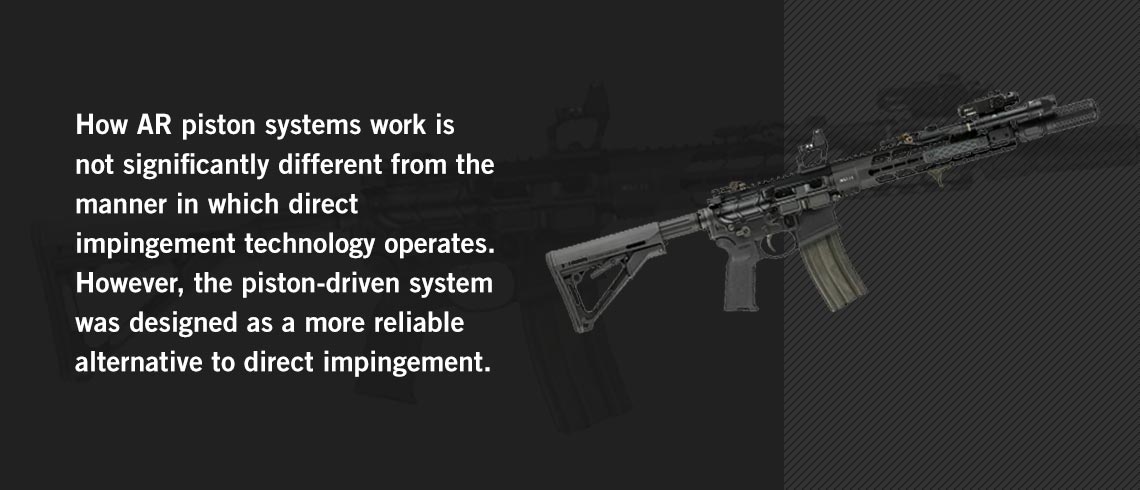
How Do the New Piston Technologies Work?
If you're drawn to gas piston AR-15s but don't want to purchase a separate upper, you might consider a piston-driven AR system. This is a relatively newer semi-automatic innovation that's growing increasingly popular with firearm owners.
The AR-15 piston system is also gas-based. How AR piston systems work is not significantly different from the manner in which direct impingement technology operates. However, the piston-driven system was designed as a more reliable alternative to direct impingement.
The major distinction is that the gas is forced into a separate cylinder rather than the gas tube. Instead of the gas triggering movement itself like with direct impingement, the cylinder contains a metal rod called the piston, which causes the bolt carrier to move backward to manage the extraction and ejection process.
The built-up gas pressure forces the piston toward the back of the gun, moving the bolt and cycling the action. Because the gas flows into a chamber to activate a piston instead of being pushed back into the receiver, piston-driven systems can keep your firearm cooler and cleaner during use.
You can actually hold the bolt carrier in your hand without fear of burning even after firing 100 rounds in rapid succession. The magazine will also continue to look clean even after firing. This can be especially advantageous to military personnel and other users who may engage in intensive firing activities.
With the development of AR-15 piston kits, you can easily turn a direct impingement system into a convenient piston-driven AR.
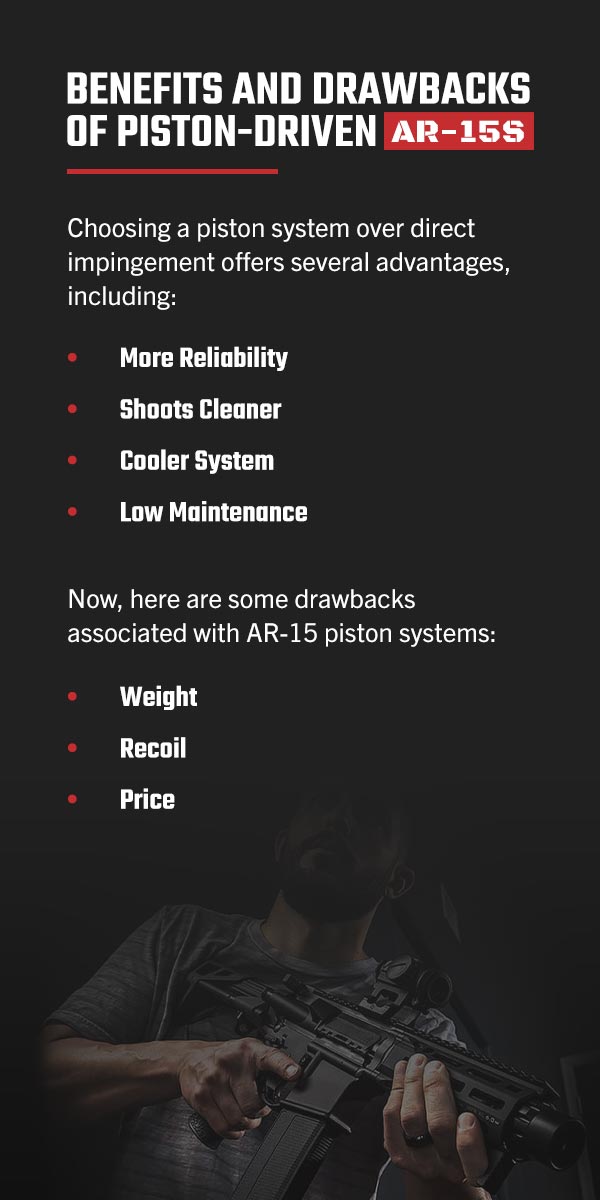
Benefits and Drawbacks of Piston-Driven AR-15s
Choosing a piston system over direct impingement offers several advantages, including:
- More reliability: Because the gas activates the piston with this type of system rather than traveling back through the tube, an AR-15 piston kit can allow for a more reliable firearm.
- Shoots cleaner: With piston-driven gas systems, there's less carbon and gas buildup in the barrel, trigger and bolt carrier group since the gases exit through the front of the gun, outside of the gun and away from the shooter. This allows it to shoot cleaner than a direct impingement system.
- Cooler system: A piston-driven AR-15 prevents gas from flowing into the receivers. This keeps the gun cooler even during heavy and continuous use.
- Low maintenance: Keeping gas out of the lower and upper receivers reduces the amount of carbon buildup on the parts — keeping them clean for longer periods and preserving their mechanisms.
Now, here are some drawbacks associated with AR-15 piston systems:
- Weight: AR-15 piston systems add about a pound of extra weight to the firearm, which could be a big disadvantage to those who prefer a lighter, nimbler gun.
- Recoil: Although the piston is regarded as accurate and reliable, they do produce more recoil, which can slightly affect accuracy on follow-up shots. Additionally, piston systems typically aren't as suppressor-friendly as direct impingement systems.
- Price: The higher cost may also be a drawback for some gun owners — expect to pay up to $500 more for a gun with an AR-15 piston system as opposed to its direct impingement counterpart. However, you may find that the benefits available with piston systems are well worth the added expense.
Our AR-15 Piston Kits
At Wing Tactical, our AR-15 piston conversion kits provide simple yet advanced installation to help you upgrade your firearm. They include all instructions and parts needed to install them without unnecessary hassle.
Our kits can accommodate nearly any gas system, including carbine-length, pistol-length, rifle-length and mid-length. They also provide flexibility in choosing your desired mount style, such as clamp-on or set screws.
Our selection makes it easy to find an AR piston kit that meets your needs, enabling you to combine the qualities of an AR-15 with a clean, durable gas piston system. You can also enjoy benefits like law enforcement and military discounts, fast shipping and handpicked products when you shop at Wing Tactical.
Find the Right AR Piston System With Wing Tactical
When choosing between direct impingement and a piston system, consider factors like how much you can afford to spend, what you plan on using it for and how often you will clean it.
If higher cost and weight aren't an impediment, a piston-driven system may be the right choice for greater reliability and fewer cleaning requirements. If you prefer to save some money, clean your AR-15 often and want something more lightweight, a direct impingement system might be a good choice.
Like anything else in the world of firearms, the best piston system depends on your preferences and operations. At the end of the day, there's no right or wrong answer.
For help deciding which one better suits your needs, turn to Wing Tactical. Contact us to learn more about how AR piston systems work and whether piston or direct impingement systems are the better choice for you.
